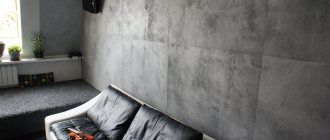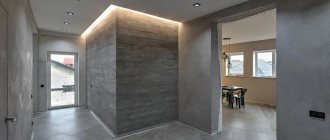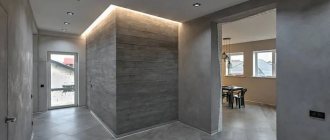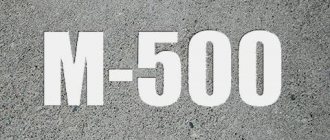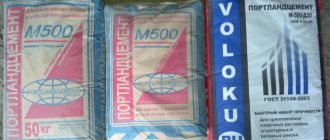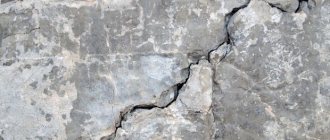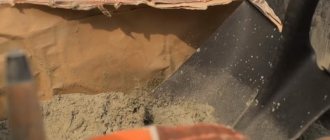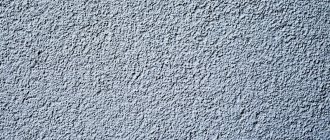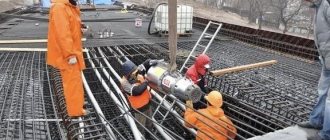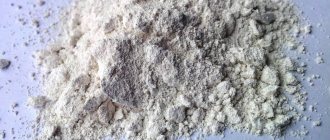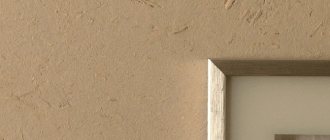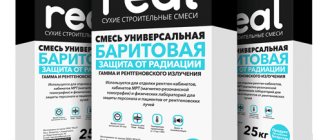Beton-House.com
Website about concrete: construction, characteristics, design. We combine the experience of professionals and private craftsmen in one place
Decorative plaster
Concrete walls are an ultra-fashionable and stylish solution for a modern interior. They came to us along with such styles as hi-tech and loft. Despite the monochrome and rough texture of the walls, they are able to make the interior warm and cozy. Concrete walls themselves require finishing to protect their porous, vapor-permeable surface.
Modern decorative concrete-like plaster comes to the rescue. Its use allows you to protect a concrete wall, as well as recreate the required texture on surfaces made of any materials. Therefore, stylish concrete walls in the interior have become available to everyone.
What is decorative plaster for concrete?
The secret of a good renovation is perfect walls. To decorate an apartment in the currently fashionable loft, grunge or military styles, decorative concrete-like plaster is ideal. These are special mixtures based on microcement or microconcrete. Using them, walls are finished quickly and efficiently, and different textures are reproduced. After renovation, the apartment looks creative and fashionable.
Concrete plaster
Decorative concrete plaster is used to decorate various rooms:
- commercial;
- industrial;
- residential
It successfully complements the interior and combines with:
- plank floors;
- glass windows;
- wooden furniture;
- brick partitions;
- iron decorative objects - lamps, chairs and others.
Manufacturers and reviews
Before purchasing, it is important to familiarize yourself with reputable companies that sell this material. Large companies value their reputation, so you can’t expect low quality from them. Prof decor is a Russian construction company. Works closely with both domestic and foreign markets. The company is rapidly growing and developing. Customers are satisfied with the products and service, which is why the company has positive reviews. Permuro - offers high quality plaster and a large range of colors. It is difficult to find products from this company on the Russian market. The prices are attractive, so they sell out quickly.
German manufacturers Caparol and Ceresit do not set the highest prices, but are among the market leaders. This leadership is ensured by the high quality and structure of the product. Perfect for budget renovations. San Marco is a company from Italy that produces plaster mixtures from polymers. The environmentally friendly material has high air tightness and antibacterial properties. Over time, the applied plaster does not collapse. During operation, it is plastic, so a wide variety of relief can be applied. Beton d'archi is a French company that produces high-quality products. Decorative plaster perfectly conveys the industrial atmosphere of the loft style and fits harmoniously into modern high-tech. The peculiarity of this material allows you to create different textures and apply the mixture in different ways. With proper and careful finishing, the walls acquire a sophisticated look.
Features and types of plaster
Dry, ready-made plastic mixtures for plastering are available in stores. They differ in composition, advantages, and disadvantages from conventional cement. They contain various additives and additives that improve properties. The mixtures also contain sand, small pebbles or stone chips to result in a rough, heterogeneous “playing” wall.
Manufacturers produce mixtures based on microcement or microconcrete.
| Base microcement | Micro concrete base | |
| Compound | Aqua cement, microfino, polymer additives, dye, no mineral chips | Cement, modifying additives, resins, dye, quartz chips |
| Application area | Interior, bathroom, toilets, furniture | External and internal works |
| Mix structure | Very thin, homogeneous | Porous |
| Properties | Resistance to salts and chlorine, high humidity | High plasticity, adhesion, hygroscopicity |
Advantages and disadvantages
Any material has advantages and disadvantages. The advantages of concrete compositions outweigh their disadvantages.
The material is lightweight, but at the same time durable. Any walls covered with these mixtures do not become heavier.
The coating is heat resistant. Applying concrete plaster is permissible on a metal, plastic or wooden base. The composition has good adhesion to the material it is coated with. Another advantage is the fact that decorative plaster for concrete does not absorb any foreign odors (even the strongest ones).
Classification of decorative plaster by types of fillers
Mixtures based on aquacement are highly resistant to moisture. Using them in rooms with constantly high humidity is an excellent solution to the problem. The advantages of plastered walls include resistance to mold, mechanical stress, and non-flammability.
The concrete composition is easy to apply and dries quickly. With its help you can create various patterns and decorative effects. Surfaces covered with this plaster are easy to clean and resistant to chemicals.
After applying the composition, there is no construction waste left. Plaster goes well with other materials used in the interior. Using mixtures, they eliminate and hide defects on the surface of the walls. The compositions also have good sound and noise-absorbing properties.
Despite the advantages, there are still disadvantages. Decorative plaster for concrete is not a cheap finishing material. In addition, when carrying out work, the mixtures have a toxic effect on the body, so follow the instructions for use and observe safety regulations.
Textured plaster Maitre Deco “Le Beton” concrete effect 9 kg
Available for this plaster
In order to select and get a color code, use the Palette .
Order tinted plaster, indicating the color code you like in the delivery comments. Please note that ordering tinted plaster is only available with 100% prepayment.
Please also note that the color rendering on the screen of your device may differ from the actual color. For a more accurate color selection, please visit our stores.
LE BÉTON is a textured decorative coating with the effect of processed or, conversely, polished concrete.
Suitable for creating a wide variety of artistic effects. Suitable for application to almost any pre-prepared mineral base (concrete, concrete blocks, brickwork, cement, cement plaster, gypsum, gypsum plasterboards), as well as chipboard, fiberboard and other wooden surfaces.
Material properties:
- Made from environmentally friendly ingredients
- Visually smoothes the wall surface
- Warm to the touch
- The effect of decorative concrete in one layer
- Hides minor base defects
- Does not shrink
- Non-flammable, fire safety class KM1
- Certified for children's and medical institutions
Surface preparation:
Apply the material to a uniform, pre-leveled, dry and clean surface. If necessary, remove existing weak parts and loose layers of old paint with a spatula. Before application, protect unpainted areas with mounting tape or film. Treat the surface with AMORСE primer in one layer (consumption 0.1-0.2 l/m² on a smooth surface, drying time 2-3 hours) with a roller or brush to improve adhesion with subsequent layers of finishing materials, strengthening and removing dust from the surface. After complete drying, to color align the prepared surface, apply BASE QUARTZ primer paint (consumption 0.15-0.30 kg/m², drying time 6-12 hours) the resulting surface has a slight roughness. If necessary, after the first layer has completely dried, apply a second layer. Use a brush in hard-to-reach places
Application:
Before applying TRAVERTIN, carefully mix by hand. The material is ready for use. Application should begin from the upper left corner, moving to the lower right. To avoid noticeable seams on the surface, always work on a wet edge, leaving a minimum amount of material around the edges. To enhance the decorative effect, it is recommended to use the following materials as a finishing layer: EFFET MÉTALLISÉ, CIRE TEINTÉE, LAQUÉ MAT, LAQUÉ PERLÉ.
Drying: at an ambient temperature of +22°C and a relative air humidity of no more than 65%, permissible complete drying is 24 hours, wet cleaning no earlier than after 28 days. Drying time may vary depending on ambient temperature and humidity.
Technology of applying plaster under concrete
At the preliminary stage, it is necessary to prepare tools and personal protective equipment. It’s easy to make a list of them based on the advice of professionals:
- Apply the composition using gloves, respiratory protection (respirator, protective mask), vision protection (glasses, transparent shield).
- Before applying plaster, the surface is cleaned of old coating. To prepare the walls, the ideal solution would be a grinding machine, spatulas, and sandpaper of various grain sizes.
- To apply the mixture, use a spatula, a trowel for layer-by-layer application, and a sponge for shading.
- To work, you will need a bucket or large container for diluting the dry mixture, an electric drill, and a mixer attachment for mixing.
The mixtures are sold both dry and ready-made, already diluted.
Before applying a new coating, prepare the surface:
- the old coating is removed;
- irregularities are removed;
- obvious defects are eliminated - cracks, chips, potholes;
- covered with primer (after this the surface must dry completely).
Then decorative mixtures are applied. If the composition is purchased in dry form, it is diluted following the manufacturer's instructions.
It is important to remember that concrete plaster sets instantly, in about 30-40 minutes. Work quickly or do not dilute too much dry mixture at once. At the end of the process, the surface is covered with 3 layers of protective varnish to prevent destruction.
Apply layer-by-layer plaster under the concrete:
- Base layer. Its thickness is determined by the size of the granular inclusions present in the composition. The layer must dry completely, then it is sanded with sandpaper (grit up to 130).
- The main (or intermediate) layer. It is left raw, since here a texture (pattern) is formed on the surface. Using a sponge, broom or corner of a spatula, create streaks, scratches, and strokes. Next, the layer should dry. After this, it can be adjusted using sandpaper.
- Special impregnation against moisture (if necessary).
- Ironing and polishing. Rub the surface with wax. The easiest way to do this is with a sanding machine with a soft felt or wool attachment.
A simple and quick way to apply decorative plaster under concrete - video tutorial.
Work technology
Before starting repairs, the old coating is removed from the walls. Plaster that has begun to crumble is removed using a spatula. To do this, it is recommended to wet the surface with water and wait a little. After this, the plaster will come off the walls much easier. The same steps are performed if the wall was covered with wallpaper. In addition, water will help clean the walls from construction dust. All irregularities and protrusions are removed to create a smooth surface. Difficulties will arise if old paint remains on the walls. To solve this problem, a special compound is purchased from a hardware store at a hardware store. With its help, the paint will dissolve and can be easily removed. If there are cracks in the wall, they are deepened, cleaned of dust, and then filled with mortar.
If mold is found on the walls, treatment with an antifungal agent is required. By the way, many construction companies sell plaster with antibacterial properties.
Primer
After the surfaces are cleaned of old coatings, the walls are primed. This step is required. The soil mixture promotes good adhesion of the material to the wall and will also reduce the likelihood of mold. The primer composition is not diluted with water. To apply to the surface, it is better to use a wide brush - it will be easier than with a narrow brush, from which everything will flow. After applying the first layer, you need to wait until it dries completely. Then the next layer is applied.
Preparation of material and preparation of solution
The next stage of work is preparing the working staff. The mixture is mixed with water. It can be either purchased or prepared independently. To make the mixture yourself, mix cement plaster, dyes and putty mixture. The ratio of materials is selected by eye. Water is added until it reaches the desired consistency. If the mixture was purchased in a store, when diluting it, follow the instructions.
Plastering
Now the diluted mixture is applied to the surface. The plastering stage begins. Using a spatula, finished material up to 2 mm thick is applied to the wall. This way the first base coat is applied. After it dries, it needs to be smoothed out. Only after this the next one is applied. The laying of the second layer is completed, and now it’s time to start forming the texture. The plaster should be a little damp. Patterns are made with a grid, stencil, spatula, or roller. Then you need to wait until the plaster dries. After this, unevenness and roughness on the surface are removed. As a rule, the drying period lasts at least an hour. Sandpaper is used to give the walls a smooth surface.
To prevent the plaster from collapsing, the surfaces are treated with varnish or wax. To add shine, special paints are used.
Famous manufacturers
The leaders of the Russian market are firmly held by five compounds recognized by builders:
- Knauf (Germany). Products are high quality and inexpensive. Plasters for concrete are produced on the basis of Knauf Diamond cement. There are 4 varieties sold in stores to create different surface options: rough, granular structure (coat), grooved (bark beetle), with different fractions of inclusions. Base color is white. But after plastering, painting in any other shade is acceptable. Suitable for external and internal work. After application, plastered surfaces are resistant to moisture and light mechanical stress. Easily tolerate high humidity. Not bad for insulation, sound insulation.
- San Marco (Italy). With the help of these mixtures, durable cement patterns are created in the interior. Concrete plaster is durable, breathable, and harmless to humans. Consists of cement with acrylic-siloxane copolymers. Using plaster, you can easily achieve the effect of aged concrete or formwork. Price segment – premium. There are 30 types on the market. The advantage is economical consumption of material. On average it is 0.8-1.3 kg/m2.
- Spiver (Italy). So-called Venetian plasters. Used for external and internal work. Many types are sold, creating coatings with different effects: imitation marble, natural stone, shimmering crystals, velvet, craquelure (crack effect) with inclusions. The consumption of the plaster mixture depends on the selected composition.
- VGT (Russia). There are 16 types of concrete plaster on sale with various texture effects, including bark beetle and Venetian. Suitable for external and internal work. Basically, these are textured mixtures with dolomite inclusions. Craftsmen achieve the effect of natural stone or concrete when decorating walls. The compositions are suitable for interiors with rough textured surfaces in loft and military styles.
- Lakra (Russia). Available in 3 versions. There is plaster for concrete with the effect of fur coat, bark beetle, graininess. Suitable for external and internal work. It is used for plastering walls and ceilings. Base color is white. They add color to the composition or paint surfaces already covered with plaster. High resistance to moisture, weathering, and mechanical stress. No more than 2 kg of solution is required per 1 m2 of surface.
Peculiarities
The main feature of working with this material is that the mixture is applied in 2 or more layers to the surface. When using plaster, it is important not to forget about its toxic properties. To do this, keep gloves and a respirator on hand. Many people choose this material for interior decoration because it lends itself to future treatments. Construction companies sell many ready-made compositions with design effects:
- imitation concrete - both rough and interspersed;
- light rust;
- metallic shine;
- fresh cement.
You can add originality by adding special dyes. The color does not change over time. Walls covered with plaster are not demanding. Surfaces should only be wiped with a damp cloth. Plaster also has the property of not fading.
The plaster takes a long time to dry and is very plastic, so before it dries completely, you can form any pattern, design, or ordinary irregularities.
Using plaster in the Loft style
One of the common types of finishing is plastering. Concrete-like plaster applied to the interior makes it easy to implement bold ideas. Imitation of a rough stone or concrete surface is popular and is actively used to decorate loft-style apartments.
Fans of the style are attracted by the brutality and the impression of reliability of the walls. People feel protected. This interior, in ensemble with the minimalist decoration of the apartment, gives such a feeling.
Gray concrete has different shades and a rich range of colors. In combination with interior items in loft solutions, it looks perfect. Concrete and stone with a feeling of cold emphasize the warmth of natural materials, which are additionally used in furnishing an apartment or house.
Decorative plaster for concrete in the interior
Concrete wall in apartment interior
It is quite difficult to use pure concrete during repairs. Beginners should not get involved in this matter and use other materials for decoration.
Concrete itself is a rather dark material (due to its color). To reduce darkness, use a large number of light sources in the room. Artificial lighting can well emphasize the texture of walls.
The concrete wall is gray, but its shades can vary from dark gray to white. Painting can be done at the concrete production stage, or after construction. Also, this material can subsequently be decorated in any way the owner wishes - you can hang some paintings, mirrors or panels.
Artificial lighting can well emphasize the texture of walls.
Pros and cons of this design solution
Pouring walls with concrete has the following advantages:
- The service life of such walls is more than a century;
- Withstands loads of up to one ton;
- Virtually immune to rust, ultraviolet rays, heat, cold and water, not afraid of parasites, chemicals and even radiation;
- The cost of this material is low.
Concrete also has disadvantages:
- Cracks spoil the finished product due to its insensitivity to traction and breaking loads;
- Low sound insulation, does not allow air and moisture to pass through;
- Portland cement is used for production;
- To obtain concrete of certain properties, various additives can be used.
The service life of such walls is more than a century.
